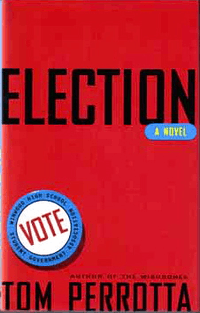Election (novel)
| Election | |
|---|---|
 First edition cover | |
| Author | Tom Perrotta |
| Country | United States |
| Language | English |
| Genre | Black comedy |
| Publisher | Putnam Adult |
Publication date | March 9, 1998 |
| Media type | Print (Hardback & Paperback) & Audio Book |
| Pages | 200 pp |
| ISBN | 0-399-14366-1 |
| OCLC | 37322216 |
| Dewey Decimal | 813/.54 21 |
| LC Class | PS3566.E6948 E43 1998 |
Election is a 1998 novel by Tom Perrotta. It is a black comedy about a high school history teacher who attempts to sabotage a manipulative, overly-ambitious girl's campaign to become school president. In 1999, the novel was adapted into a film of the same title.
Synopsis
The novel centers on a high school in suburban New Jersey, where students are preparing to vote for their school president. The story takes place in 1992, amidst the U.S. Presidential Elections that year. Tracy Flick is an unpopular girl but very ambitious, intelligent and manipulative; however, she is not quite as perfect as her classmates assume. She had a heated sexual affair with her former teacher, and after Tracy told her mother of their relationship, his career and marriage were ruined. One of Tracy's current teachers, James T. "Jim" McAllister, known as "Mr. M." to his students, learns that Tracy is taking part in the election, and feeling that Tracy needs to be taken down a notch, prompts Paul Warren (a student of whom he approves) to run against her. In turn, Paul's outcast lesbian sister, Tammy, begins a reckless campaign to be school president in retaliation to her ex-girlfriend who is now dating Paul. The novel ends with Mr. M ultimately losing his job as a teacher when it is found that he has sabotaged the election by pocketing Tracy's winning votes- making Paul the winner of the presidency. Mr. M then ends up working in a car dealership.
Reception
The novel was a moderate success and received critical praise. The San Francisco Chronicle called it a "darkly eerie and winning new novel", and The New York Times wrote that the novel "provides gratifyingly exact and telling portraits of the kids themselves. Solid plotting guarantees that the reader really does want to learn who wins when the ballots are finally counted."[1]